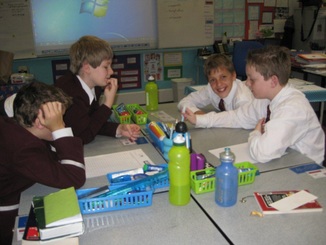Include a range of teaching strategies.
Standard 3.3

Effective teaching is not the drilling and trilling
to the less than willing.
John Hattie, Visible Learning, p. 25
to the less than willing.
John Hattie, Visible Learning, p. 25
Strategies that promote inquiry
Source: Kath Murdoch, 1998. Classroom Connections: strategies for integrated learning. Armadale, VIC. Elenoar Curtain Publishing.
Strategies that help create independent learners
The capacity to set goals and work towards them is a critical aspect of becoming a successful life long learner. In order to be a truly independent, self-managing learner, students must develop teh skills and qualities that both enable and inspire them to continue to improve and expand their learning throughout their lives. I intend to apply these strategies in my classroom:
Strategies that personalise and connect learning
Strategies for effective questioning
Practice asking good questions before you enter the classroom
- Tuning in - brainstorming, bundling, puzzles, graffiti board, finish the sentence, mind mapping, paired interviews, mystery boxes, rocket writing
- Sorting out - through media and visual arts, through mathematics, through music, through english
- Going further - individual projects, contracts, cooperative groups, expert groups, multiple intelligence work stations
- Making conclusions - board games, Bloom's box, concept map, content based cloze, crossword puzzles, diamond display, DeBono's six thinking hats, effects wheels, learning maps, PMI
- Taking action - exhibitions, advertising campaigns, hear all about it, letter writing, personal pledge
- Sharing, discussing and reflecting - carousel sharing, class meetings, focused reporting, watch this space, class diary, learning logs, self-assessment.
Source: Kath Murdoch, 1998. Classroom Connections: strategies for integrated learning. Armadale, VIC. Elenoar Curtain Publishing.
Strategies that help create independent learners
The capacity to set goals and work towards them is a critical aspect of becoming a successful life long learner. In order to be a truly independent, self-managing learner, students must develop teh skills and qualities that both enable and inspire them to continue to improve and expand their learning throughout their lives. I intend to apply these strategies in my classroom:
- make teaching and learning intentions explicit
- negotiate success criteria
- explicitly teach students how to set goals for themselves
- use journals and log books to help students track and reflect on their process
- spotlight how the learning is taking place as well as what learning is taking place
- provide formative feedback
- establish clear rules and routines
- ensure that students are clear about the requirements of the task
- conference with individual s or small groups to check progress
- teach effective work habits
- run targeted skills workshops such as notetaking, summarising and organising notes
- know when to provide scaffolding and when to take it away
- invite students to share what they want to learn and how they like to learn
- group students for different purposes
- encourage self and peer assessment
- foster reflective thinking and metacognition
Strategies that personalise and connect learning
- Seek out what students already know, can do and understand, and use this to inform planning
- Discuss why we need to explore a particular topic, how we will share the learning and how we might use it in the future
- Record these initial responses (e.g., using anchor charts, mind mapping, graphic organisers or KWL charts) for mapping the shared journey
- Pose guiding questions
- Identify and clear up any misunderstandings
- Find hooks to create student interest and meaning making
- Seek opportunities for linking the community with programming and planning
- Use technology in meaningful ways
- Create space where students can investigate and share their learning interests
- Create opportunities to involve families
- Encourage students to connect learning with issues of personal , local or national significance
- Identify the relevance of a topic beyond the classroom
Strategies for effective questioning
Practice asking good questions before you enter the classroom
- What is the meaning of ..?
- How does this fit with your experience?
- What else do you know about ..?
- Is there a link between .. and ..?
- What might be some different perspectives?'
- How can we use your strengths to help you learn?
- When you watched that program, how did it connect to your life?
- Who might see this differently? What do you hope for your future?
- Are there extra skills you think you need? How can I support you?
- How can you use this learning in other ways?
- There are community groups that may be able to help you with this issue.
- Do you know how to get in toouch?'
Strategies that make learning visible
Strategies for developing thinking skills
Strategies for working collaboratively
Strategies for investigating through technology
Strategies that promote transfer
- Anchor charts
- Graphic organisers
- Harvard's Ground Zero Project - Thinking Routines
- Displaying success criteria
- Gallery walks (e.g., display student's work as in an art gallery and agree on a focus for the viewing. This enables 'piggy back' thinking to build connections between ideas)
Strategies for developing thinking skills
- Thinking gears, Harvard University's 'Project Zero'
- Bloom's taxonomy
- De Bono's thinking hats
- Thinker's keys
- Brainstorming
- Debates
- KWL
- PMI
- Diamond ranking
- Journals
Strategies for working collaboratively
- Think, pair, share
- 1-3-6 consensus
- Role playing
- Jigsaw
- Cross-age groups
- Peer assessment
- Fishbowl observations
Strategies for investigating through technology
- PowerPoint/ Excel
- Kid Pix
- Inspiration
- Making a web page
- Multimedia presentations
- Digital photos
Strategies that promote transfer
- Gradual release of responsibility
- Scaffolding
- Modelling
- Think-alouds
